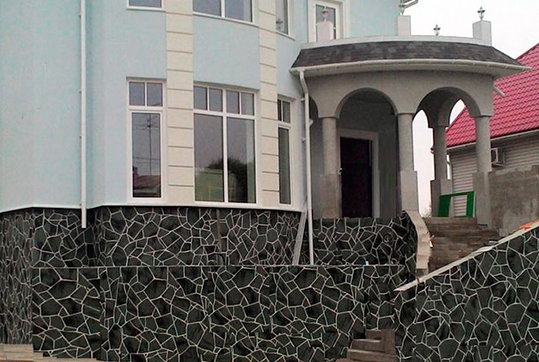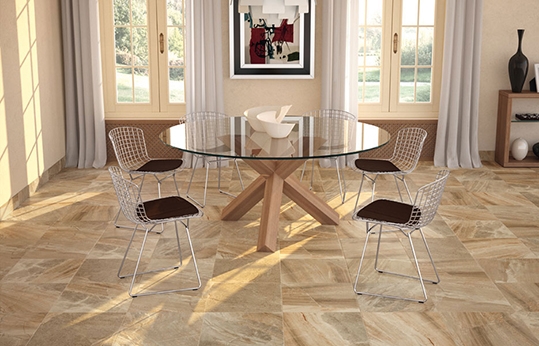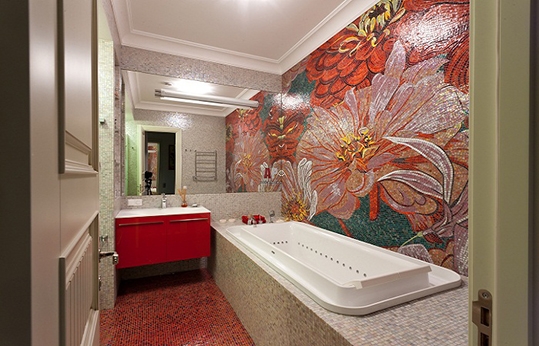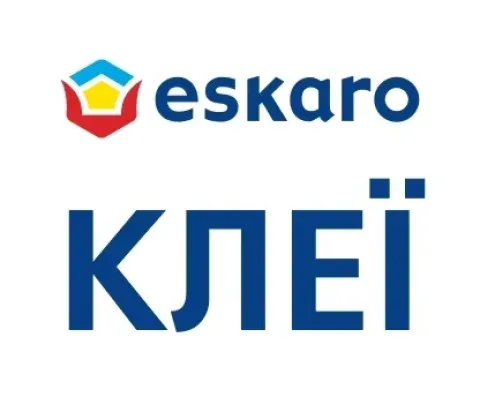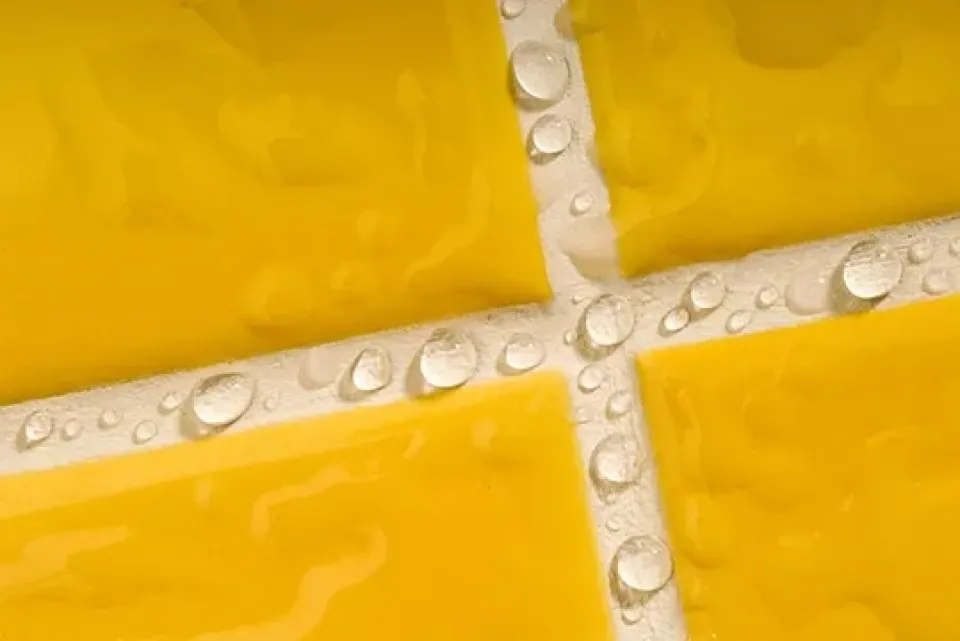
Strengthening the grout for facing tiles
«To strengthen or not to strengthen? That is the question....»
Folk (almost after Shakespeare).
Facing tiles are a widespread and relevant finishing building material. Today, it is rare to find a house in which there is no tiled cladding in principle. Even a small piece of the surface (inside or outside) is still decorated with tiles (glass mosaic, ceramic tiles, porcelain stoneware, natural or artificial stone) on the facade, on the floor, on the walls, and sometimes even on the ceiling. And if there are tiles themselves, the inevitable consequence is the presence of seams between individual tiles. These are the so-called "compensation seams", which perform a very important task: they help prevent the facing tiles from cracking and from coming off the base in the event of its deformation (increase/decrease in linear dimensions), which occurs during heating/cooling of the tiles and increase/decrease in humidity in them.

After laying the tiles, the expansion joints cannot be left open - they must be filled with a special material with special properties, which sometimes contradict each other. These properties are: compressive and bending strength, water repellency, elasticity, abrasion resistance, the presence of a certain color of the filler material, resistance to washing out the color of the material and resistance to fading under the influence of ultraviolet rays. And if the tiles will be operated in particularly difficult conditions (exposure to fats, acids, alkalis, high water pressure), then even more stringent requirements are imposed on the material with which the expansion joints are filled.
Why should the seams not be left open? Because moisture can easily penetrate through an open seam, which will destroy the adhesive layer and the base on which it is applied, as well as the unglazed side of the tile. In addition, dust and dirt will accumulate in the seams, which, together with moisture, will contribute to the appearance of "unwanted vegetation" (mold, fungus, moss). These negative factors will lead to damage to the surface covered with tiles.

To fill expansion joints, several types of materials are currently offered (they are called "grouting mixtures" or "joints"), these are: dry cement-based powders, epoxy resins, silicone sealants, acrylic water-dispersion products. We will not fully disclose the properties of each material, but will focus on only one of them - dry cement-based powders. This is due to the fact that currently the vast majority (not less than 98%) of grouting works (both indoors and outdoors) are performed with joints, which are offered for sale in the form of dry cement-based powders.

This type of grout (fugue) belongs to the "dry building mixtures" and, like all similar materials, requires the addition of a mandatory ingredient before use - water (or an aqueous dispersion of a special latex) for "mixing".
In fact, cement-based fugue in ready-to-use form is one of the varieties of concrete, namely, "heavy" (from 1800 to 2500 kg/m3) concrete. The difference between concrete and fugue is only that there is no coarse aggregate - crushed stone in fugue. But this does not change the essence of the matter, because other components of concrete are present in fugue: sand (filler), various additives (plasticizers, water repellents, etc.), pigment (colored powder). In cement joints, the same processes occur as in concrete, and the main role is played by cement and water, which during interaction ("hydration") bind all the components of the joint into a single structure and form a monolithic "cement stone".
Depending on the size of the filler, joints are divided into: joints for filling narrow (up to 6 mm) joints - with a fine fraction of sand as a filler, and joints for filling wide (over 6 mm) joints - with a coarser fraction of sand. Joints also differ in the degree of strength, elasticity, water resistance - these properties depend on the type and brand of cement, as well as the presence and amount of special additives.
There is another type of cement joint - joints for clinker (for joints up to 20 mm). This mortar uses coarse sand, as well as the mandatory presence of reinforcing and hydrophobic (water-repellent) additives, because clinker tiles are used in places with increased operational load (on facades, on floors with high traffic, etc.).
Continuing the comparison of grout with concrete, we will find that there are much more brands of concrete than types of cement grout. Usually, one manufacturer offers 1-2 varieties of cement grout, as an exception - 3-4 varieties. At the same time, the number of offered brands of concrete is at least 10 times more. This is explained by the fact that concrete is produced at concrete plants in relatively large volumes to order for various special conditions of use and is sold in finished form. Depending on the specifics and purpose, different components and their different quantities are used in the manufacture of concrete.
Unlike concrete, grout is sold in small volumes, packaged from 1 kg to 20 kg in the form of a "semi-finished product" - a dry mix. In addition, all grouts are sold "in color" (in the form of colored cement powder). The permanent palette of one type of grout is from 15 to 50 colors and is offered by the manufacturer in 2-3 types of packaging. How much retail space will be needed to place the entire “set” of grouts that will correspond to all brands of concrete in all colors of the palette and in all packaging?
It is for this reason that the grout manufacturer tries to give his product “universality” of application, limiting himself on the store shelves to one or two of the most “popular” (from an economic point of view) grouts, in favor of a wider palette of colors. However, “universal” products are always worse than “specialized” products. To correct this situation, some manufacturers offer to additionally use special additives for their “universal” grouts. These additives really improve the properties of “universal” grouts, namely: they increase their adhesion, elasticity, resistance to abrasion, strength, moisture resistance, resistance to fuel and lubricants, etc. Typically, such additives are in the form of an aqueous dispersion of special alkali-resistant latexes. These aqueous latex dispersions are presented either as a ready-made liquid for mixing cement grout (used instead of water for mixing), or as a concentrate, in which case the concentrate is first mixed with water in the recommended proportion, and then, diluted, is used to mix cement grout instead of water.
Manufacturers of special additives usually recommend using them only for one or two types of cement grout of their trademark. The special liquid latex additives themselves are offered on the Ukrainian market “less than the fingers on the hand” and the price for them is quite high, because this is an exclusive imported product.
Among “general builders” there is a widespread opinion that it is supposedly possible to use PVA glue as an additive in concrete (grouts) or to mix concrete (grouts) using general construction permeable water-dispersion primers instead of water. As they claim, the quality of concrete (grout) is the same as when using special liquid latex additives, and the costs are 4-5 times less. However, this opinion is erroneous, because PVA glue and "cheap" primers are not alkali-resistant materials. The dispersions of which they are composed are destroyed in the fresh alkaline environment of concrete (grout), turning from adhesives into a useless "cheese" mass, which becomes part of the concrete filler (grout), and a filler with very low strength characteristics, which leads to a deterioration in the grade of hardened concrete (grout).
Eskaro offers two special alkali-resistant latex additives developed by it that improve the properties of cement grouts for tile joints.
One of them Aura Fixtur ready to use, and the other Aura Krafting Effekt – is a concentrate. One of the main advantages of additives over similar products is that they are not limited to use in conjunction with any one specific cement grout. The additives have shown their effectiveness when tested with a range of cement grouts of the Ceresit, Mapei, Sopro, Mira, Kiilto, BauGut, Baumit brands, which are currently represented on the construction market of Ukraine. In addition, both additives are pleased with their price, which, calculated per 1 kg of grout, is at least 2 times lower than the price of similar additives. The additives are especially recommended for surfaces exposed to atmospheric influences and increased mechanical wear. Aura Fixtur and Aura Krafting Effekt improve the elasticity and adhesion of the grout solution, the operational and mechanical properties of the grout joint. The use of additives allows you to seal the joint, reduce its porosity, increase its water repellency and weather resistance and extend its service life. The introduction of additives reduces the likelihood of the formation of efflorescence on the grout joints, the appearance and growth of mold (fungus, moss). A very important point is that the use of additives does not change the original color of the grout (additives after drying are colorless) and, in addition, they allow you to maintain the stability of the grout color for a long time, increase resistance to color washing. Additives do not impair the vapor permeability of the grout, and, if necessary, it is possible to further apply additional water-repellent agents to the grout (but in this case, preliminary testing is necessary). Despite such a number of positive qualities, additives Aura Fixtur and Aura Krafting Effekt are not a "cure for all occasions". For example, they are not recommended for use on objects that are constantly under water (for example, for swimming pools). Recall that the additive Aura Fixtur – is a ready-to-use product that is used instead of water to prepare a cement grout solution. But the additive Aura Krafting Effekt is a concentrate and it is recommended to mix it with clean cool water first, and then add the cement powder of the grout for the joints. The recommended proportions for preparing the grout (using the example of Saumalaasti TM Kiilto grout) are indicated in the consumption tables.
Consumption table
| Water | 0,27 l | 0,54 l | 0,8 l | 1,6 l |
| Aura Krafting Effekt | 0,05 l | 0,1 l | 0,15 l | 0,3 l |
| Cement grout powder for joints | 1 kg | 2 kg | 3 kg | 6 kg |
Таблиця витрати
| Aura Fixtur | 0,32 l | 0,64 l | 0,96 l | 1,9 l |
| Цементний порошок фуги для швів | 1 kg | 2 kg | 3 kg | 6 kg |
The grout solution should be prepared (mixed) in accordance with the grout manufacturer's recommendations. It is recommended to mix the grout with a drill at low speed with a nozzle (whisk) for dry mixes. Sealing joints with grout with the added additive should be carried out in accordance with the grout manufacturer's instructions for use. The additives are offered in convenient containers: Aura Krafting Effekt in a 0.3 l container, which is enough to add to 6 kg of dry mix, and Aura Fixtur in 0.33 l and 1 l containers.
Please note that an overdose of additives increases the adhesion (sticking) of the solution to the surface of the tiles and makes it difficult to clean them from excess mortar after the work is done. Therefore, unglazed, matte and porous tiles should be moistened with water before sealing the joints and check the quality of their cleaning from excess grout on a small area. The finished grout should not be liquid (excessive increase in the amount of mixing liquid causes shrinkage of the joint) and should not be too thick (it will be impossible to fill narrow joints to their full depth - the thickness of the tile).
In the article, we examined the advantages of a “universal” cement grout when a special water-based latex dispersion is added to it. You yourself have to answer the question: “to strengthen or not” the tile grout. If you are building for yourself and for a long time, then the answer suggests itself.
